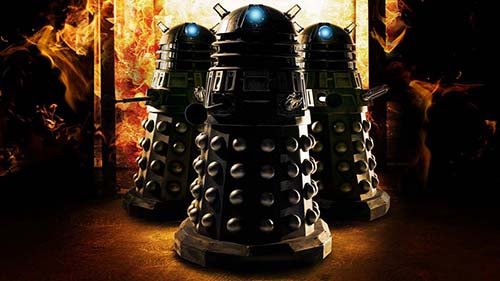
Do you wish you could time travel? Have you ever wanted to go to another planet? Or are you just simply a fan of anything British? If the answer is yes to any of those, Doctor Who is the show for you. With series 11 set to premiere October 7, now is the time to get on board.
As the longest running sci-fi show in history, catching up on the last 55 years of Doctor Who may seem a little overwhelming. Thankfully, you don’t need to know every detail to become a Whovian — that’s what we call ourselves. But to make the transition a little smoother, here’s a crash course on Doctor Who.
THE DOCTOR
 The Doctor is from the planet Gallifrey, and belongs to a species known as ‘Time Lords’, one of the most advanced beings in the universe and known for mastering, you guessed it, time travel. She is somewhere between 2,000 to four-and-a-half-billion years old (it’s complicated), spending her life travelling through time and space using a TARDIS, saving lives and seeing the sights of the universe.
The Doctor is from the planet Gallifrey, and belongs to a species known as ‘Time Lords’, one of the most advanced beings in the universe and known for mastering, you guessed it, time travel. She is somewhere between 2,000 to four-and-a-half-billion years old (it’s complicated), spending her life travelling through time and space using a TARDIS, saving lives and seeing the sights of the universe.
The Doctor’s true name is a mystery, as is Time Lord custom, instead choosing the title of Doctor to represent her devotion to helping people. Also, make sure to never refer to the character as ‘Doctor Who’ with other Whovians. Although the Doctor was originally credited as ‘Dr. Who’, so that name is technically correct, but you don’t want to get drawn into any debates just yet, so just stick to ‘the Doctor’.
You may have noticed that a variety of actors have taken the role of the Doctor. That’s because when Time Lords are mortally wounded, their bodies undergo a process called ‘regeneration’, in which every cell in their body heals itself, completely changing the Doctor’s appearance and personality. Usually, a Time Lord only has twelve regenerations, but the Doctor was gifted a whole new regeneration cycle a few years ago. As such, Jodie Whittaker’s take on the character will be the thirteenth Doctor (and the first female version!). Although, technically she’s the fifteenth Doctor because… actually, it’s a complex history; don’t worry about that for now!
TARDIS
 Short for ‘Time and Relative Dimension in Space’, a TARDIS is a living machine that the Time Lords use to travel through time and space. The Doctor’s TARDIS appears as a police telephone box from 1950s Britain, due to a malfunction in its camouflage, which the Doctor never fixed because she simply loves the look. A look that’s now iconic in British pop culture.
Short for ‘Time and Relative Dimension in Space’, a TARDIS is a living machine that the Time Lords use to travel through time and space. The Doctor’s TARDIS appears as a police telephone box from 1950s Britain, due to a malfunction in its camouflage, which the Doctor never fixed because she simply loves the look. A look that’s now iconic in British pop culture.
The interior of the TARDIS exists in a different dimension to the outer shell, meaning that it’s bigger on the inside; it’s something that surprises new travellers every time. The main area of the TARDIS is the control room, from which the Doctor pilots the TARDIS from place to place, but the interior expands far beyond that. So there’s plenty of room for people to join the Doctor on her adventures!
COMPANIONS
 Once called the Doctor’s assistants, and often simply referred to as ‘friends’, the Doctor’s companions are the people deemed trustworthy and interesting enough to travel with the Doctor in her TARDIS. They’re not always human, with the occasional lizard or robotic dog tagging along, but they always are ready to help the Doctor save the day, or just ask the Doctor what those ‘sciencey’ words mean.
Once called the Doctor’s assistants, and often simply referred to as ‘friends’, the Doctor’s companions are the people deemed trustworthy and interesting enough to travel with the Doctor in her TARDIS. They’re not always human, with the occasional lizard or robotic dog tagging along, but they always are ready to help the Doctor save the day, or just ask the Doctor what those ‘sciencey’ words mean.
Of course, travelling through time and space can be dangerous, and not every companion has made it home. But even those who have fallen never regretted jumping into that blue box.
MONSTERS AND ENEMIES
 History and the universe aren’t just filled with good people, and the Doctor has made countless enemies over the years. The upcoming series supposedly contains only new villains, but you can be certain that the Doctor will eventually encounter old foes. We’d love to talk about all the Cybermen, Sontarans, Weeping Angels and more, but we’d be here listing monsters forever; so, let’s just look at a couple of the Doctor’s most enduring enemies.
History and the universe aren’t just filled with good people, and the Doctor has made countless enemies over the years. The upcoming series supposedly contains only new villains, but you can be certain that the Doctor will eventually encounter old foes. We’d love to talk about all the Cybermen, Sontarans, Weeping Angels and more, but we’d be here listing monsters forever; so, let’s just look at a couple of the Doctor’s most enduring enemies.
The oldest and most iconic monster in Doctor Who are the Daleks, a warrior race of aliens, genetically engineered by a madman, Davros, after countless years of civil war on the planet Skaro. The alien mutant is housed within a mobile metal casing, shaped somewhat like a salt shaker, with what appears to be a plunger and egg whisk.
 But don’t let those television budgets from the 1950s fool you; the Daleks are the deadliest of the Doctor’s enemies. While the Doctor tries to spread love and unity throughout the universe, the Daleks hate all other lifeforms, with the ultimate goal of being the only species in existence. The only species to rival the Daleks in power are the Time Lords. Both had even driven each other to near extinction during the Great Time War.
But don’t let those television budgets from the 1950s fool you; the Daleks are the deadliest of the Doctor’s enemies. While the Doctor tries to spread love and unity throughout the universe, the Daleks hate all other lifeforms, with the ultimate goal of being the only species in existence. The only species to rival the Daleks in power are the Time Lords. Both had even driven each other to near extinction during the Great Time War.
The Master also has a long history with the Doctor. A traitorous Time Lord that grew-up with the Doctor, The Master’s lust for power drove these childhood friends apart. As a Time Lord, the Master has also regenerated a few times, with the most recent being portrayed by Michelle Gomez. But throughout Doctor Who’s history, the Master has fought against, and occasionally alongside, the Doctor, with their deep personal connection making their battles particularly exciting to experience. Although the Master is supposedly dead, she’s managed to cheat death many times in the past.
BUT WHERE DO I START?
This can seem a bit daunting, considering that Doctor Who has a 50-year history, with over thirty seasons; movies, specials and spin-offs; plus countless comics, video games and radio dramas (it’s almost all canon!). But that’s alright. New Who’s upcoming eleventh season has been quoted many times as the perfect jumping on point for first-time viewers. Though, if you really want to get a head start, you should go from the 2005 relaunch with the ninth Doctor, played by Christopher Eccleston. It sets up the tone of the whole series revival (as long as you can look past some of the dated CGI).
Once you really get into the depths of Doctor Who, we absolutely suggest going back and watching at least some of the classic series. Storylines such as 1975’s Genesis Of The Daleks have set the tone for the series going forward, and are a great insight into the Doctor’s morals, even into the modern day. It’s a sign of what makes Doctor Who a classic, and something that’s bound to continue into the distant future.









